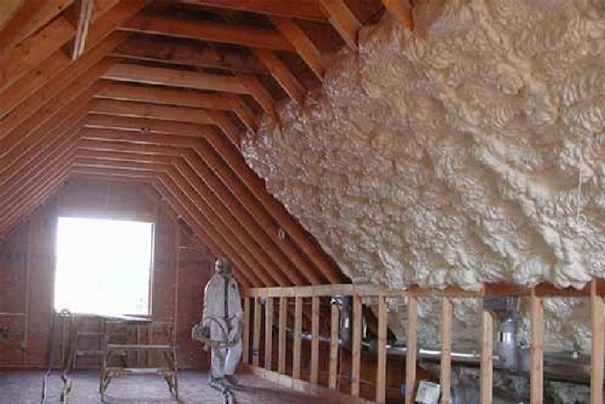is an open-cell polyurethane spray foam insulation. Installed on-site, it can be used to insulate basement walls, above-grade walls, attics, floor cavities, and interior partitions for sound attenuation. Icynene can significantly improve the energy efficiency of a home as well as improve the home's moisture management, leading to greater durability.
Icynene, open-cell polyurethane spray foam insulation. Wall cavity application.
There are several factors that contribute to Icynene's energy efficiency. As Icynene is sprayed, it expands to 100 times its volume almost instantly. As it does so, it completely fills and seals the entire wall, floor, and roof cavities, which creates a complete air barrier. The creation of an air barrier via insulation is particularly useful, as both interior and exterior air barriers are difficult to construct and maintain. This ‘fool-proof’ air barrier greatly reduces the amount of unwanted air infiltration, which typically makes up a significant percentage of a home's heating and cooling requirement.
When Icynene is used to insulate an attic, it is typically sprayed between the roof rafters, as opposed to between the ceiling joists. Installing the insulation at the roof line keeps the attic within the conditioned space. This is very important if HVAC equipment and ductwork is contained in the attic. A vented (i.e. unconditioned) attic is at outdoor temperature in the winter and can rise above 120°F in the summer. As such, even if the ductwork and equipment are insulated, there will be significant energy loss from these components in an unconditioned attic. Using Icynene to enclose the attic within the conditioned space eliminates these energy losses, which greatly improves the efficiency of the system and leads to smaller heating and cooling loads.

Cathedral attic application.
The vast majority of moisture that migrates through a wall travels on air currents. Since Icynene significantly reduces the airflow through a wall, it also reduces that moisture that can enter the wall. As such the chance of moisture accumulation, mold growth, and ultimately structure rot is substantially reduced.
The one main drawback to Icynene is cost. On average, the installed cost is about 2-3 times more than fiberglass batt. We've found that the payback is typically 6-10 years, based on energy modeling that we've done. This payback, along with the improved durability and performance, is often acceptable to our custom design clients while the extra cost is sometimes a deterrent to production builders.
Leave a Reply